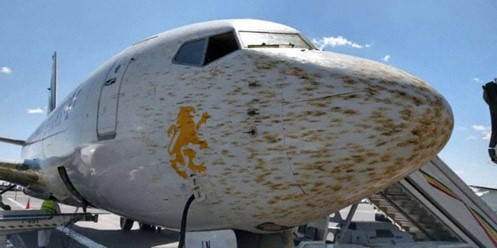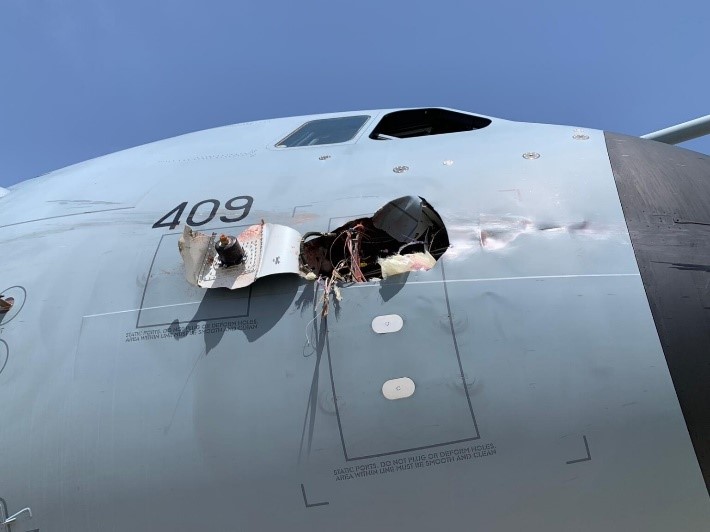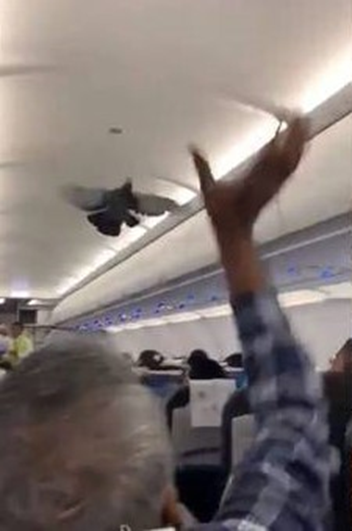 it
it  en
en
Archive 2020
On 1st November in Tampa, Florida, a Spirit Airlines A320 during the approach suffered several impacts on the cowlings of both engines. After the next take-off, several hours later, the aircraft was forced to return for unknown reasons. This news seems worthy of being reported for two reasons: the first is to highlight once again how frequent can be the involvement of more engines of the same aircraft in case of multiple impacts with birds, with all the possible consequences, and the second to show that even the most accurate inspections carried out after a possible ingestion may not determine the presence of damage that can compromise the engine running during the flight.
The following article, in addition to the news of the title above, contains several information on the prevention strategies against bird strikes adopted on the second main airport of the Chinese capital.
An article published on the website Arynews complains about the intensification of bird strikes at Pakistani airports, which leads to costly maintenance and aircraft grounding. The article again highlights how the problem is related not only to the lack of proper devices to remove birds, but above all to the shortcomings in the handling of waste around the airport.
Another article highlights the initiatives of the Pakistani aviation authority to mitigate the phenomenon
... and another one announces that the aforementioned aeronautical authority has decided, as an immediate measure, to hire 12 shooters to be deployed around the Lahore airport. They therefore adopt the principle “desperate times call for desperate measures” supposing they know, however, that the problem will not be definitively resolved except through the continuous removal of food waste around the airport.
We had at the time reported the news of a serious inconvenience which occurred in Congo:
Compagnie Africaine Aviation A320, during the take-off run an engine ingested a bird prompting the crew to reject take off at high speed; as result all the four tyres of the main gear deflated;
Now the BPEA of the D.R. Congo has released the final report with a great deal of recommendations.
The Covid 19 pandemic has severely affected also air transport, causing the grounding of numerous aircraft.
The long stopping period, even with all the necessary precautions, has somehow allowed insects to take possession of delicate parts of an aircraft. Following a rejected take-off, carried out on 16 June 2020 by a Wizz UK A321 at Doncaster airport, the AAIB found out some insect larvae, approximately the size of a grain of rice, deposited within the No 1 pitot probe, causing the inefficiency of a speed indicator and the consequent rejection of take-off. It should be noted that the crew had carried out a double pre-flight inspection just in consideration of the long period of downtime. The text of the Bullettin issued by the AAIB follows:
- 29 September 2020
Fort Mackay (Canada), Canadian North B737, during the initial climb through 3000 feet the crew felt vibrations from the left engine, declared emergency and decided to divert to Fort McMurray where landed about 20 minutes later. Maintenance found several fan blades damaged consistent with hitting a large bird. - 29 September 2020
Lahore, PIA A320, hit by a bird in unknown conditions; damage to both engines are reported;

(Photo taken from Arynews)
- 5 October 2020
Knoxville (TN), Commutair ERJ145, on final at about 1NM from the runway hit a little bird; minor damage; - 9 October 2020
Washington (Dulles), Republic ERJ175, bird strike on final; - 12 October 2020
Pori (Finland), Budapest Aircraft Service EMB 120, multiple bird strike with gulls after take off; immediate landing back;
https://yle.fi/uutiset/3-11590899 - 14 October 2020
London (Stansted), Ryanair B737, during the take-off run struck a barn owl that, despite being injured, has been saved, as reported in the following article:
https://www.bishopsstortfordindependent.co.uk/news/stunned-owl-revives-after-crash-with-aircraft-9126661/ - 22 October 2020
Tabatinga (Brasile), Azul Linhas Aereas ERJ-195, was accelerating for takeoff when the crew spotted a dog crossing the runway and rejected takeoff. However the dog was struck by the nose gear.
https://www.aeroin.net/aviao-da-azul-com-73-a-bordo-aborta-decolagem-apos-atropelar-um-cachorro/ - 24 October 2020
Iwakuni (Marine Corps Air Station, Japan), “Patriot Express” (carrier n.a.) B767, bird strike in an unidentified flight phase forces passengers to an overnight stay in the military base.
https://www.stripes.com/news/pacific/bird-strike-in-japan-forces-overnight-stay-for-patriot-express-passengers-1.650451 - 26 October 2020
Salt Lake City (UT), Skywest CRJ200, on final a bird struck the nose cone; - 26 October 2020
Joinville (Brazil), Azul ERJ195, during the take off roll some birds collided with the nose gear and were ingested by the right engine. The crew rejected takeoff; minor damage. - 1 November 2020
Dublin, Aer Lingus A320, the crew reported multiple bird strikes on rotation and increased vibrations on the right engine, that was running normally however. A brief flame from the right engine was also reported from the ground. The aircraft landed back about 16 minutes after departure. - 1 November 2020
Tampa (FL), Spirit Airlines A320, on approach the aircraft flew though a flock of birds and received a number of bird strikes; damages to both engine cowlings are reported; on the next takeoff several hours later the aircraft needed to land back. - 2 November 2020
Sochi, S7 Sibir A321, during the take off roll the crew needed to reject takeoff at about 80 KIAS when a bird was ingested by one of the engines; no damage. - 4 November 2020
Berlin (Brandenburg), Easyjet A320, during the initial climb an engine ingested a bird prompting the land back 30 minutes after departure.
https://simpleflying.com/easyjet-suffers-bird-strike-on-first-day-of-brandenburgs-new-runway/ - 6 November 2020
Seattle (Boeing Field, WA), UPS B757, upon rotation the aircraft encountered a bird strike and ingested birds into one of its engines. The crew decided to land back 18’ later.
https://simpleflying.com/ups-757-bird-strike/ - 8 November 2020
Fort Worth Alliance (TX), Sun Country Airlines B737, after landing the crew reported a bird strike resulting in the loss of hydraulic pressure and loss of nose wheel steering. The aircraft was towed off the runway about 30 minutes after landing. - 9 November 2020
Pori (Finland), Budapest Air Service EMB-120, durung the climb the reported the aircraft had flown through a flock of birds and had received a number of bird strikes. The aircraft landed back about 30 minutes after departure. - 9 November 2020
Palma Mallorca, Iberia Express A320 during climb the crew reported that an engine had ingested a bird. The aircraft landed back about 12 minutes after departure. Flight cancelled, the passengers were rebooked onto flights the following morning.
https://www.euroweeklynews.com/2020/11/11/bird-strike-disrupts-palma-to-madrid-flight/ - 10 November 2020
Atyrau (Kazakistan), SCAT Airlines B737, during the initial climb the aircraft flew through a flock of ducks or geese and received a number of bird strikes, one engine ingested a number of birds and began to emit unusual noises. The crew landed immediately back.
https://www.thesun.ie/news/6140635/plane-passengers-birds-engine-fire/
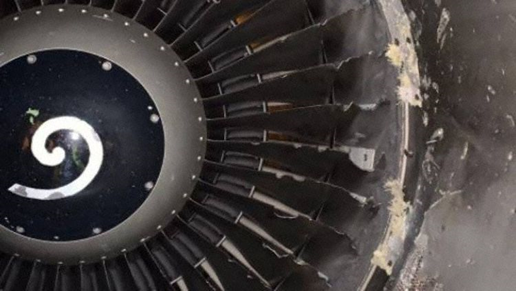
(The engine after landing; phot SCAT taken from Avherald.com)
- 12 November 2020
Boston (MA) or Newark (NJ), United B737, a post flight inspection revealed the left hand engine had ingested a bird, there was also damage to the leading edge of the left hand wing. - 14 November 2020
Yakutat (AK), Alaska Airlines B737, during the landing when the captain felt an impact at the left side of the aircraft. After made a backtrack on the runway the crew saw the carcasse of a dbrown bear on. The aircraft hit a female brown bear and killed the mother, her cub estimated about 2 years old remained uninjured. Damage to the left engine's inlet and cowling.
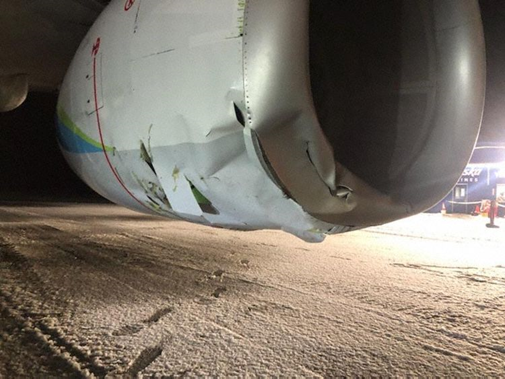
(The damaged engine; Photo: Scott McCurren taken from Avherald.com)

(The bear after the impact; photo taken from Breaking Aviation News & Videos)
- 21 November 2020
Chicago (O’Hare, IL), Envoy Air EMB 145, after departure the crew was forced to land back because of a probable bird strike that damaged the windscreen.
https://www.foxnews.com/travel/american-airlines-plane-damaged-bird-airport
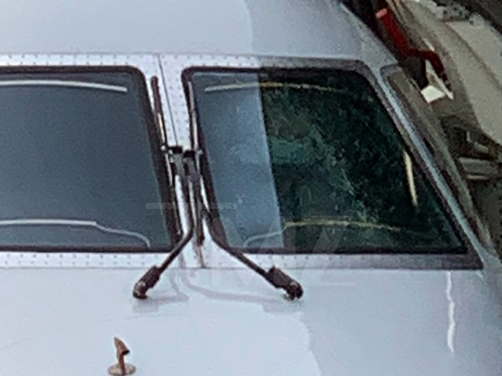
(The damaged windscreen; photo taken from TMZ.com)
- 21 November 2020
Sacramento (CA), Southwest B737, during the approach the aircraft struck several birds damaging engine cowl. - 28 November 2020
Kinshasa (DR Congo), Mwant Jet ERJ145, during the initial climb a bird struck the left windshield causing it to crack; immediate return.
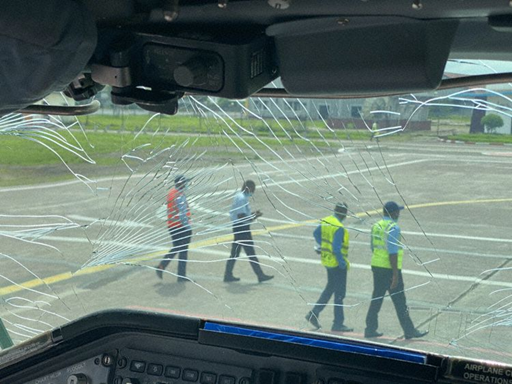
(The windshield after the impact; photo Gueda Yav Wicht Taken from Avherald.com)
- 28 November 2020
Lagos, Ethiopian Airlines B777, on approach the freighter aircraft received a bird strike that damaged a wing.
http://www.newdawnngr.com/2020/11/28/ethiopian-airline-plane-survives-bird-strike/ - 29 November 2020
Minneapolis (MN), Sun Country B737, on approach the right hand engine ingested a bird.
https://www.aeroinside.com/15098/sun-country-b738-at-minneapolis-on-nov-29th-2020-bird-strike - 4 December 2020
Sacramento (CA), Fedex MD10, on approach a bird impacted the nose of the aircraft; - 14 December 2020
Gibraltar, Wizzair A320, bird strike on approach; the aircraft was unable to depart for its return flight due to the need of an inspection. The flight has been postponed to the next day.
https://www.gbc.gi/news/second-ever-wizz-air-flight-gibraltar-breaks-down-after-bird-strike - 16 December 2020
Rome (Fiumicino), Alitalia A320, rejected take off due to a flock of birds, probably gulls, that was settled on the runway and rose up. - 23 December 2020
Omaha (NE), Envoy ERJ175, on approach the aircraft flew through a flock of geese receiving multiple bird strikes to both wings and the right hand engine. - 23 December 2020
Omaha (NE), PSA Airlines CRJ-900, a postflight inspection revealed damage to both wings and the fuselage that resulted from bird strikes. - 24 December 2020
Islamabad, Serene Air B737, on final approach a bird impacted and cracked the right hand windshield of the cockpit;
https://tribune.com.pk/story/2277235/passenger-flight-suffers-bird-hit-while-landing-at-islamabad-airport

(Photo taken from Avherald.com)
- 30 December 2020
Lagos, British Aiways B777, on final approach the aircraft received a number of bird strikes in the flare causing a hydraulic leak, the loss of nose wheel steering after landing and smoke seen from the main landing gear. The crew stopped the aircraft on the taxiway; a remarkable delay (11 min.) is reported regarding the arrival of the first 2 firemen with portable fire extinguishers, and 16’ for the first truck.
https://simpleflying.com/british-airways-777-nigeria-bird-strike/
Statistics show that most bird strikes occur at altitudes between 0 and 1000 feet (300 meters), i.e. at or near airports. With regard to this, prevention measures and procedures are concentrated mostly on airports. Two episodes have recently occurred that go beyond the usual framework. On 29 August and 1 September (see below) two aircraft suffered a bird strike at an altitude of approximately 10,000 ft. (3000 mt.) respectively in the skies of Japan and Russia. The first event occurred during the climb of the aircraft, the second during the descent. The distance from the airports, given the altitude where the impacts occurred, is about 15 kilometers. We remind that the main international regulators prohibit the settlement of human activities that might attract wildlife in an area with a radius of 13 kilometers from any airport.
Although landing back for a bird ingestion into an engine is now a fairly frequent occurrence, this news went around the world because the Vice President of the United States was on board. In the video, sparks are clearly seen coming out of the right engine of the AirForce 2. The event occurred on 22 September 2020.
With an interesting article, The Ethiopian Herald emphasizes the risk of impacts with wildlife in the autumn months, due to the end of the rainy season and the arrival of migratory birds wintering in the country. The article also contains some significant data relating to the Addis Ababa Bole airport and the costs suffered by the national airline Ethiopian Airways due to wildlife strikes. In conclusion, they recommend that all aeronautical operators report all impacts, emphasizing the importance, for the purpose of prevention, of achieving a database as complete as possible.
At the time we published the following accident report:
PSA Airlines CRJ700, in the initial climb the crew reported a loud bang; a runway inspection found a dead deer on the runway; then the crew positioned for a low approach to have the gear inspected from the ground receiving the information that all three gear were in position; in the meanwhile either from the tower and from another pilot it appeared there was vapour coming off the right side and the right engine appeared to be leaking; after landing the fire crew confirmed the fuel leak from the right engine, reported a lot of fuel on the runway and foamed the aircraft; the occupants exited the aircraft rapidly; damage to the leading edge of the right wing due to the impact with a deer;
Five previous incidents are known to have happened at Charlotte-Douglas International Airport involving deer:
- In 1994 a USAir DC-9 returned after hitting a deer on takeoff; no damage.
- In 1996 a USAir Boeing 737-300 hit several deer after landing; minor damage.
- In 2002 a Piedmont Airlines DHC-8 hit a deer after landing, causing the nose landing gear to collapse
- In 2009 a Republic Airlines ERJ-170 hit a deer after landing on runway 36C; no damage.
- In 2010 a US Airways Boeing 737-400 hit a deer after landing; no damage;
- (source: Aviation Safety Network)
The NTSB now released the final report on that event:
The article below reports a series of collisions between aircraft and wildlife at some Canadian airports during the springtime months of the current year (2020).
Many feared that the lockdown induced by the pandemic could affect airports, reducing the number of flights and airport services, including bird control. The airport area and its surroundings would have been gradually reoccupied by wildlife, creating some risk for aircraft.
The Pakistani national airline PIA has publicly complained about the high number of impacts suffered by its aircraft in recent times (June and July 2020), blaming this situation for the poor waste management at Karachi and Lahore airports and in the surrounding areas.
The Pakistani Civil Aviation Authority immediately responded by announcing the imminent installation of a modern electronic bird scaring system from the runways of the country's main airports. These devices essentially consist of “distress call” systems, i.e. the emission of alarm sounds of birds in distress that should drive away the birds of the same species.
This system is widely used throughout the world, but we believe that the truly and definitively effective tool is the organization and ecological management of urban waste around airports.
This video has been seen worldwide but we propose it again because it plastically highlights the risk of a bird strike with ingestion into an airplane engine. We observe that the pigeon is not at all frightened by the noise of the engine or by the movement, and this should lead us to evaluate also these aspects when studying the best prevention and removal strategies.
- 01 July 2020 – Eindhoven
Wizz Air A320, the aircraft took off from runway 21 at 17:29 hours local time and struck one or more birds at 500 feet altitude. The flight crew issued a Pan Pan call and requested a holding pattern to troubleshoot. They reported an unreliable airspeed indication. After consulting with their company, it was decided the aircraft could continue the flight to Skopje, North Macedonia. The flight left the holding after 15 minutes and proceeded towards their destination.
- 03 July 2020 – Tunis
Tunisair A320, at take off the aircraft received a bird strike. In the absence of any abnormal indications the crew continued the flight to destination (Munich). A post flight inspection revealed a dead pigeon was entangled in the nose gear, the pigeon presumably was trying to escape a bird of prey, which was ingested by the right hand engine causing some fan blade damage.
- 13 July 2020 - Bergamo
Ryanair B737, during the takeoff run struck a Hooded Crow (Corvus cornix); in the absence of abnormal parameters the crew continued the flight to the destination airport where the bird was found entangled in the nose wheel;
- 13 July 2020 – Riga
Air Baltic CS-300, during the initial climb received a bird strike; the crew initially continued the flight but later decided to return to the departure airport where landed about 75’ after take-off..
- 14 July 2020 – Beledweyne (Somalia)
Bluebird Dash 8, during the landing an obstacle suddenly appeared that the crew unsuccessfully tried to avoid; the aircraft veered off and eventually collided with a heaps of sand on the landing strip edge, burning into flames. The three people on board were rescued and no injury has been reported; according to authoritative sources the “obstacle” was a donkey.
- 15 July 2020, Tunis
ASL Airlines Belgium B737, on short final a flock of gulls settled on the runway threshold lifted off and struck the aircraft; three dead gull found dead on the runway; no damage.
- 15 July 2020 – Columbus (OH)
Mesa Airlines ERJ175, after take-off flew through a large flock of birds; the crew maintained routine communication and arrived to destination; the FAA reported unknown damage.
- 26 July 2020 – Amsterdam
Delta A330, was about to enter the oceanic crossing to the US when the crew decided to return to Amsterdam due to a suspected bird strike at the right hand side; flight cancelled.
- 26 July 2020 – Pantelleria
Volotea B717, was accelerating for takeoff when the crew rejected takeoff due to a bird strike; the impact happened on the right side of the aircraft damaging a pitot tube and causing an airspeed indication failure;

(The right hand pitot tube hit by the bird; photo taken from Avherald)
Incidents like this are not rare as shown by the following photo of the remains of a Bald Eagle skewered by a Challenger 300 pitot tube (place and date unknown):
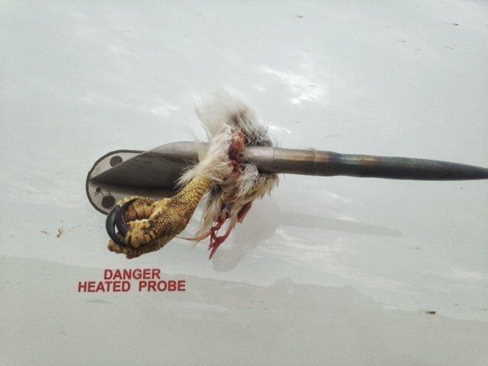
- 4 August 2020 – Poznan
LOT ERJ 195, at takeoff the aircraft received a bird strike. The crew continued the departure at first, then levelled off at FL240 and decided to land back 35’ after departure. After the checks on the ground. maintenance released the aircraft back to service. The aircraft departed again but suffered another bird strike. The crew stopped the climb at FL190 and diverted to Warsaw. - 8 August 2020 – Ranchi (India)
Air Asia India A320, rejected takeoff after an engine had ingested a bird and failed with a bang and sparks;
https://www.indiatvnews.com/news/india/breaking-air-asia-flight-take-off-abort-bird-hit-mumbai-ranchi-airport-latest-news-640508 - 10 August 2020 – Manchester
Jet2 B757, during the initial climb received a bird strike to the right engine; the crew decided to land back but was forced to fly in a holding pattern in order to burn off excess fuel before returning. The aircraft landed about 30’ after takeoff. - https://simpleflying.com/jet2-boeing-757-manchester-bird-strike/
- 17 August 2020 – Parigi (Orly)
Air Europa B737, during the initial climb the crew reported they possibly had received a bird strike on the landing gear but want to continue the flight. They asked for a runway inspection however. The runway inspection found two dead pigeons on the runway. Climbing through FL120 the crew reported engine trouble with the left hand engine that was reduced to idle. The aircraft was therefore forced to return to the departure airport where landed about 25 minutes after departure. - 19 August 2020 – Dusseldorf
Eurowings A319, during the initial climb hit a bird and landed back 15’ after departure; - 20 August 2020 – Dickinson (ND)
Skywest CRJ200, during the initial climb hit a bird and diverted to Rapid City (SD) where landed 40’ after departure; minor damage; - 21 August 2020 – Liverpool
Easyjet A319, during the initial climb hit a bird and landed back 20’ after departure;
https://www.dailymail.co.uk/news/article-8651545/EasyJet-plane-makes-emergency-return-Liverpool-mid-air-bird-strike.html - 21 August 2020 – Leeds
Ryanair B737, during the initial climb hit a bird and diverted to Manchester where landed 45’ after departure; minor damage; - 29 August 2020 – Tokyo (Haneda) 15 km. SE of the airport
Skymark B737, during the climb crossing about 10800 feet MSL the aircraft received a bird strike. In the absence of abnormal indications the crew continued the flight and landed in Fukuoka about 75 minutes later. A post flight inspection revealed damage to the aircraft skin on the left hand side and internal structures. - 1 September 2020 – Mosca
Red Wings A320, during the descent crossing FL100 a bird impacted the aircraft just underneath the aircraft's nose. A post flight inspection revealed the bird had penetrated the lower nose cone just at the connection to the fuselage and caused dents to the lower fuselage as well. - 10 September 2020 – St. Petersburg
Pobeda B737, went around due to the presence of a dog on the runway; - 11 September 2020 – Moscow (Domodedovo)
S7 Sibir Airlines A320, in the initial climb the aircraft received a bird strike. One of the engines began to vibrate so that the crew decided to land back about 40 minutes after departure.
https://mimicnews.com/s7-airbus-a320-returns-to-moscow-after-bird-strike-and-engine-vibrations - 11 September 2020 – Dunedin
Air New Zealand A320, bound to Wellington diverted to Christchurch due to a bird strike;
https://www.odt.co.nz/news/dunedin/bird-strike-hits-flight-dunedin-smell-spreads-through-cabin - 15 September 2020– Milwaukee (WI)
Southwest B737, rejected take off due to two large birds hitting the left hand engine; flight cancelled;
https://www.fox6now.com/news/southwest-captain-performs-rejected-takeoff-due-to-bird-strike - 15 September 2020 – Toulouse
Easyjet A320, bird strike in the initial climb; landed back 45’ after take off. - 16 September 2020 – Belgorod (Russia)
Aeroflot Sukhoi 100, on final flew through a flock of birds and received several impacts; return flight cancelled. - 21 September 2020 – Houston (Hobby, TX)
Delta B717, in the initial climb flew through a flock of birds and received a number of bird strikes. The crew then diverted to Houston Intercontinental where landed about 20 minutes after departure. The aircraft received unknown damage to multiple areas. - 22 September 2020 – Ekaterinburg (Russia)
Aeroflot Sukhoi 100, in the initial climb at 100 m. flew through a flock of birds and received several impacts; the crew decided to continue the flight to Moscow (2h20’); the Prosecution Office in charge opened an investigation into the occurrence with respect to adherence to flight safety legislation. - 27 September 2020 - Mumbai
Indigo A320, during the initial climb received a bird strike; the crew decided to land back 25’ after departure. - 27 September 2020 – Kars (Turkey)
Anadolujet B737, during the initial climb the left engine failed with a large boom and streaks of flames. The engine was shut down, the crew decided to land back about 30 minutes after departure.
https://simpleflying.com/anadolujet-engine-737/
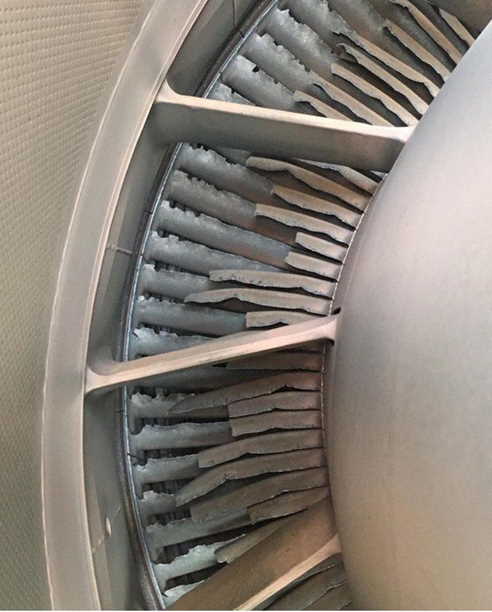
(Back of the left engine after landing; photo taken from Avherald.com) - 28 September 2020 – Karachi
PIA A320, on final approach a bird impacted the left hand wing and left a dent and fracture in the leading edge of the left wing. - 29 September 2020 – Ufa (Russia)
Azimut SU95, in the initial climb the aircraft received a bird strike prompting the crew to land back. - 29 September 2020 - Nizhnevartovsk (Russia)
Aeroflot A321, on approach flew through a flock of birds and received several impacts; a post flight inspection revealed birds hit to the radome causing a dent and fracture at the edge of the radome, left hand engine, leading edge of left hand wing and nose landing gear. Return flight cancelled.
The General Directorate of Civil Aviation of India recently issued a circular aiming to inform the aviation community about the risks caused by the swarms of locusts that periodically infest that country. The circular, which can be downloaded here, briefly describes the impact that can result from an aircraft flying through a swarm of locusts. Occlusions of pitot tubes and reduced forward vision may happen, but also there are possible risks for the air intakes and the probes of parked aircraft. The Indian authority also points out that swarms of locusts in flight can reach the remarkable altitude of 2000 meters a.s.l.
The photos below illustrate the effects of flying through a swarm of these insects better than many words.
Last May an Italian region, Sardinia, suffered extensive damage to its agricultural heritage from the passage of swarms of voracious locusts that devastated the crops.
The local press highlighted the phenomenon, also complaining about its habitual nature and the lack of suitable countermeasures by the competent authorities.
In Sardinia there are currently three civil airports open to international air traffic and one important military airport; there are also several bases for helicopter rescue, firefighting, the helicopter departments of various military forces and the Coast Guard.
There is reason to believe that other regions of Southern Italy could be affected by the invasion of locusts, a phenomenon that now recurs with constant regularity.
We are not aware at the time of any measures or notices issued by the competent national, civil or military aviation authorities, to inform the aeronautical community of the possible risk related to the presence of these insects in critical areas around airports, heliports and other aviation facilities, as well as for flights conducted at low altitude during the day, with particular reference to Sardinia.
We therefore hope that this kind of information will be provided as soon as possible by supplying proper news on the insect behaviour, on the damage they can cause to the aircraft and on the risks associated with swarms. The information should be directed at pilots, airlines, airport managers but also flight controllers and Aeroclubs, and at all the associations that deal with amateur flight.
The NTSB has published the final report related to the incident that occurred in Boise (ID) on 19 October 2019 to a Horizon Air DHC8 caused by an impact of a bird on an aircraft wing during the initial climb. It is pointed out here because the crew had visual evidence of the animal remains on the wing but nevertheless decided to continue the flight, having not experienced any control problem. A post-flight inspection revealed that the impact had partially severed had partially severed the left wing leading edge composite structure and cracked the front spar web. The link to the final report has been included in the table “Investigation & Legal” of this web site.
…and again in Russia, this time in St. Petersburg (see below), after the accident that occurred on August 15, 2019 at Moscow Zhukovsky. Once again the species involved is the seagull. We have often emphasized the lack of attention of the regulatory authorities to these events which are obstinately defined as rare and not needing measures and/or strategies of mitigation. We can only add that without a good deal of luck we would have to face the second major fatal accident in eight months.
We usually do not deal with events involving military aircraft; however, this photo describes very well the effects of a bird strike.
- 12 March – St. Petersburg
Rossya A319, during the initial climb the aircraft flew through a flock of seagulls and received a number of bird strikes followed by a sharp increase of the vibrations of both left and right hand engines, a burning odour developed on board. The crew landed back about 12 minutes after departure. A post flight inspection revealed both engines had ingested birds, both engines had several fan blades damaged, in addition the outboard flap of the left hand wing received damage. A runway inspection recovered remains of several birds. - 12 April – San Francisco
Delta B737, during the take-off run the right engine ingested at least two geese prompting the crew to reject take-off at high speed (100 kts). Flight cancelled. - 21 April – Tunis
Qatar Airways B777, on landing struck a seagull whose carcass was later found on the runway; no damage to the aircraft but return flight delayed;
https://www.news18.com/news/auto/tunisia-bound-qatar-airways-flight-encounters-bird-strike-while-landing-all-passenger-safe-2589975.html - 24 April – Charlotte (NC)
Republic Airways ERJ-175, bird strike at take off. In the absence of abnormal indications the crew continued the flight and climbed the aircraft to FL360. About half way into the flight the aircraft descended to FL280. The next leg was flown cruising at maximum FL230. - 29 April – Sao Paulo
Gol B737, during the initial climb the right engine ingested birds that caused repeated compressor stalls. The crew shut the engine down and landed back 45’ after take-off.

(The fan blades of the right engine; photo taken from Avherald.com)
- 30 April – Austin (TX)
American B737, aircraft struck birds on final damaging left wing landing light. - 9 May – Madrid
Air China B747, during the initial climb the outboard left-hand engine ingested a bird prompting the crew to land back about one hour after departure; all 38 fan blades were replaced. - 15 May – Sao Paulo
LATAM A320, about 80 minutes into the flight the crew was informed a bird strike into the left engine was suspected. In the absence of any abnormal indications or warnings the crew decided however to divert to Brasilia where the aircraft landed about 140 minutes after departure. - 18 May – Recife
LATAM B767, the left engine ingested a bird during the takeoff run prompting the crew to land back about 25’ after departure; three fan blades received damage. - 21 May – Brisbane
Nauru Airlines B737, flew through a flock of birds upon rotation. A runway inspection revealed 8 to 10 dead birds on the runway. The aircraft landed back about 70’ after departure having burnt off fuel. - 22 May – Allentown (PA)
Allegiant A320, rejected takeoff at high speed reporting a bird strike about one quarter down the runway. - 29 May – Punta Delgada (Portugal)
Azores Airlines A320, rejected takeoff at high speed (about 116 knots over ground) after the left-hand engine ingested a bird. The engine received substantial damage to fan blades and surrounding panels.

(The fan blades damaged. Photo taken from Avherald.com)
- 31 May – Munich
Lufthansa CRJ 900, during the initial climb received a bird strike against the captain's windscreen prompting the crew to land back stop about 11 minutes after departure.
https://simpleflying.com/lufthansa-crj-900-birdstrike/ - 12 June – New York (JFK)
Delta B757, about 6NM final approach to the runway the crew reported a bird strike that shattered their left windshield.
ANEPC, the national civil protection authority, has given the thumbs-down to the government’s project for a new airport terminal in Montijo on the basis that the site is ‘too susceptible to elevated risks, including earthquakes, tsunamis and ‘bird strike’.
The naturalist and writer Jonathan Franzen said it would be a crime against nature to construct an airport on the site – stressing “there simply are no alternatives for the majority of migratory birds that stop there to rest”. This increases the likelihood of ‘bird strike’ which could end up being fatal for much more than the birds…
We are used to the impacts with birds at all airports and at all latitudes, but not to seeing them flutter inside the airplanes. This is what happened to a GoAir aircraft that was preparing to take off from Ahmedabad airport: two pigeons entered the cabin during the boarding of passengers. After a tiring hunt, the birds finally left the aircraft and the flight was able to take off.
https://www.nzherald.co.nz/travel/news/article.cfm?c_id=7&objectid=12313055
- 1 January – Rockhampton (Australia)
Qantas Link DHC8, bird strike during the initial climb; returned to the departure aerodrome with minor damage;
- 1 January – Amsterdam
KLM B737, during the initial climb he right hand engine suffered a failure emitting a loud bang, streaks of flames and severe vibrations due to a probable bird strike; immediate return 25’ after departure;
- 3 January - Roatan (Honduras)
Línea Aérea Nacional de Honduras S.A. Bae Jetstream 3100, during the take-off run a large vulture impacted the aircraft's nose. The crew continued takeoff and the flight to destination.
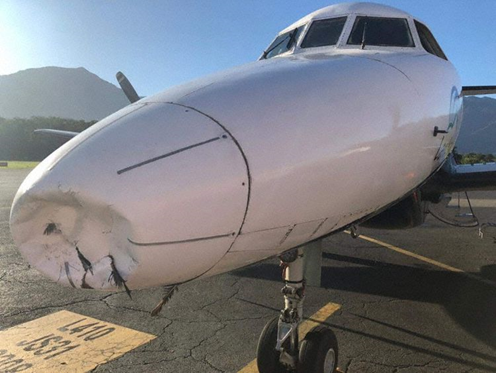
(The aircraft’s nose after the impact; photo taken from Avherald.com)
- 4 January – San Francisco (CA)
China Airlines B747, during the initial climb the crew reported that a bird strike had taken out some of their flight instruments. The crew then decided to dump fuel and land back about 75 minutes after departure. An inspection revealed that some of the AoA probes were damaged.
- 6 January – Karachi
PIA A320, during the approach a bird impacted the nose of the aircraft. The airline complained that garbage and even dead animals had not been removed from the ground underneath the approach path.
- 6 January – Karachi
PIA A320, bird strike on approach;
- 9 January – Dire Dawa (Ethiopia)
Ethiopian Airlines B737, on final approach the aircraft flew through a swarm of grasshoppers and received a huge number of insect impacts into engines, windshield and nose of the aircraft. The crew went around twice and eventually diverted to their ultimate destination Addis Ababa. A thorough inspection did not find any damage.
http://newsinflight.com/2020/01/13/grasshoppers-swarm-an-ethiopian-boeing-737-on-approach/
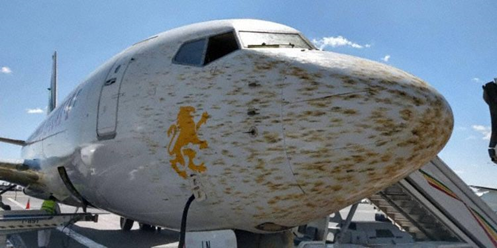
(Photo: On the Wings of Aviation taken from Avherald.com)
- 14 January – Victoria (BC)
Westjet B737, during short final the aircraft encountered a flock of geese and struck approximately 10 of them. The crew executed a missed approach and diverted to Vancouver where landed 15’ after the go-around. The aircraft nose cone had been punctured by the impact.
https://www.cbc.ca/news/canada/british-columbia/westjet-flight-hits-bird-calgary-to-victoria-vancouver-1.5426732

(The nose after landing; photo taken from Avherald.com)
- 18 January – Islamabad (Pakistan)
Etihad A320, during the landing the crew reported a collision with some animal. A runway inspection revealed a wild boar dead on the runway, the inspection of the aircraft revealed no damage. Pakistan's CAA reported the wild boar had digged its way underneath the airport perimeter fence onto the airport.
- 21 January – New York (JFK)
American B777, on short final the aircraft flew through a flock of geese and initiated a go around landing about 7 minutes after the go around. The aircraft received damage to its right hand engine when it struck the large flock of geese.
https://newyork.cbslocal.com/2020/01/21/bird-strike-gives-flight-passengers-a-scare-coming-into-jfk-airport/
- 22 January – Rio de Janeiro
LATAM Brasil A320, in the initial climb suffered a bird strike; the crew landed back 15’ after departure;
- 23 January – Kimberley (South Africa)
South African Airlink Embraer ERJ-170, was accelerating for takeoff when the crew spotted a bird on the runway; it was then ingested by the right engine that emitted banging sounds and vibrations and lost thrust. The crew decided to land back about 30 minutes after departure.
- 25 January – Moline (IL)
Envoy ERJ145, in the initial climb out the crew declared Mayday reporting a bird strike and landed back about 12 minutes after departure. An inspection spotted Canada geese nearby the runway;
- 27 January – Cluj (Romania)
Wizzair A320, after take-off the aircraft received a bird strike. In the absence of abnormal indications the crew decided to continue the flight to Charleroi. However then the crew decided to divert to Katowice (Poland), where the aircraft landed safely about 30 minutes after that decision. Airport sources reported the aircraft diverted as it needed to be changed.
- 31 January – Kisumu (Kenia)
Jambojet DHC8, bird strike on landing; one passenger sustained a minor finger injury and was immediately treated following the bird strike; the damage on the plane was yet to be established but the airline shedule had to be readjusted.
https://www.tuko.co.ke/337991-passenger-injured-bird-strikes-jambojet-plane-kisumu.html
https://www.businessdailyafrica.com/corporate/shipping/KAA-urges-airlines-to-be-on-high-alert-to-avoid-bird-strikes/4003122-5443970-96l5usz/index.html
- 3 February – Des Moines (IA)
Endeavor CRJ900, bird strike on approach;
- 11 February – San Jose (Costa Rica)
Alaska Airlines B737, apparently the aircraft suffered a bird strike during climbing, the bird hit one of the engines and the crew decided to return. The aircraft landed safely approximately 30 minutes after departure.
https://www.crhoy.com/nacionales/ave-se-estrella-contra-motor-de-avion-y-lo-obliga-a-aterrizar-de-emergencia/
- 11 February – Penza (Russia)
S7 Sibir Airlines, ERJ170, on final descending through about 50 feet the left hand engine ingested an owl that caused damage to fan blades;
- 18 February – Ahmedabad (India)
GoAir A320, rejected takeoff following an issue with the right engine caused by a bird ingestion; a small fire erupted in the engine, but this was quickly put out by airport fire services.
https://indianexpress.com/article/cities/ahmedabad/ahmedabad-airport-goair-aircraft-fire-6273718/
- 20 February – Dublin
Stobart Air ATR72, during the takeoff run hit a hare on the runway; the crew decided to land back 30’ after departure; following an inspection the aircraft was cleared for its schedule;
https://www.dublinlive.ie/news/dublin-news/dublin-airport-flight-hare-strike-17795191
- 23 February – Boston (MA)
Jetblue A321, hit a bird on rotation and had a burning odour on board, however, no abnormal indications; the crew decided to land back; the aircraft was grounded and could not fly according to its schedule;
https://boston.cbslocal.com/2020/02/24/jetblue-bird-strike-boston-logan-airport/
- 28 February – Sibiu (Romania)
Wizzair A320, during the initial climb the left hand engine ingested a bird prompting the crew to return to Sibiu about 15 minutes after departure.
- 3 March – Zurich or Los Angeles
Swiss B777, a post flight inspection after the landing in Los Angeles revealed evidence of a bird strike, the aircraft was unable to depart for the return flight that was cancelled as result.
- 6 March – Juba
Sudan Airways A320, during the initial climb an engine ingested a bird prompting the crew to land back about 20 minutes after departure. Two engine blades were found damaged as result of the bird strike.
- 7 March – Amsterdam
KLM B777, during the approach received a bird strike into one of the engines;
- 7 March – Toronto
Air Canada ERJ190, rejected take off at high speed (135 kts.) due to a bird strike;
- 8 March – Los Angeles
Qatar B777, bird strike on approach that cauused a large dent in the radome; return flight cancelled;
- 9 March – Philadelphia
American B767, during the approach the aircraft flew through a flock of geese. One of the geese struck the left Angle of Attack (AoA) sensor.
- 16 March – Knoxville (YN)
Endeavor Air CRJ900, during the initial climb the crew reported they had encountered more than 12 birds at about 5000 feet and needed to return as a precaution; the aircraft landed back 16’ after take off;
- 16 March – Zurich
Swiss CS300, during the initial climb the aircraft received a bird strike. The crew firstly continued the climb but later decided to return to Zurich. The aircraft landed back about 30 minutes after departure.
- 22 March – Norfolk (VA)
American A319, at landing two birds impacted the aircraft causing damage at the left engine;
- 30 March – Dublin
Aer Lingus A330, the crew declared PAN PAN reporting a bird strike on rotation. The crew shut the affected engine down and landed back about 35 minutes after departure. A runway inspection found a dead small bird on the runway.
https://www.breakingnews.ie/ireland/aer-lingus-coronavirus-mercy-flight-returns-to-dublin-following-bird-strike-on-take-off-990987.html
- 31 March – San Antonio (TX)
iAero B737, bird strike at rotation; precautionary landing back about 12’ after departure;
